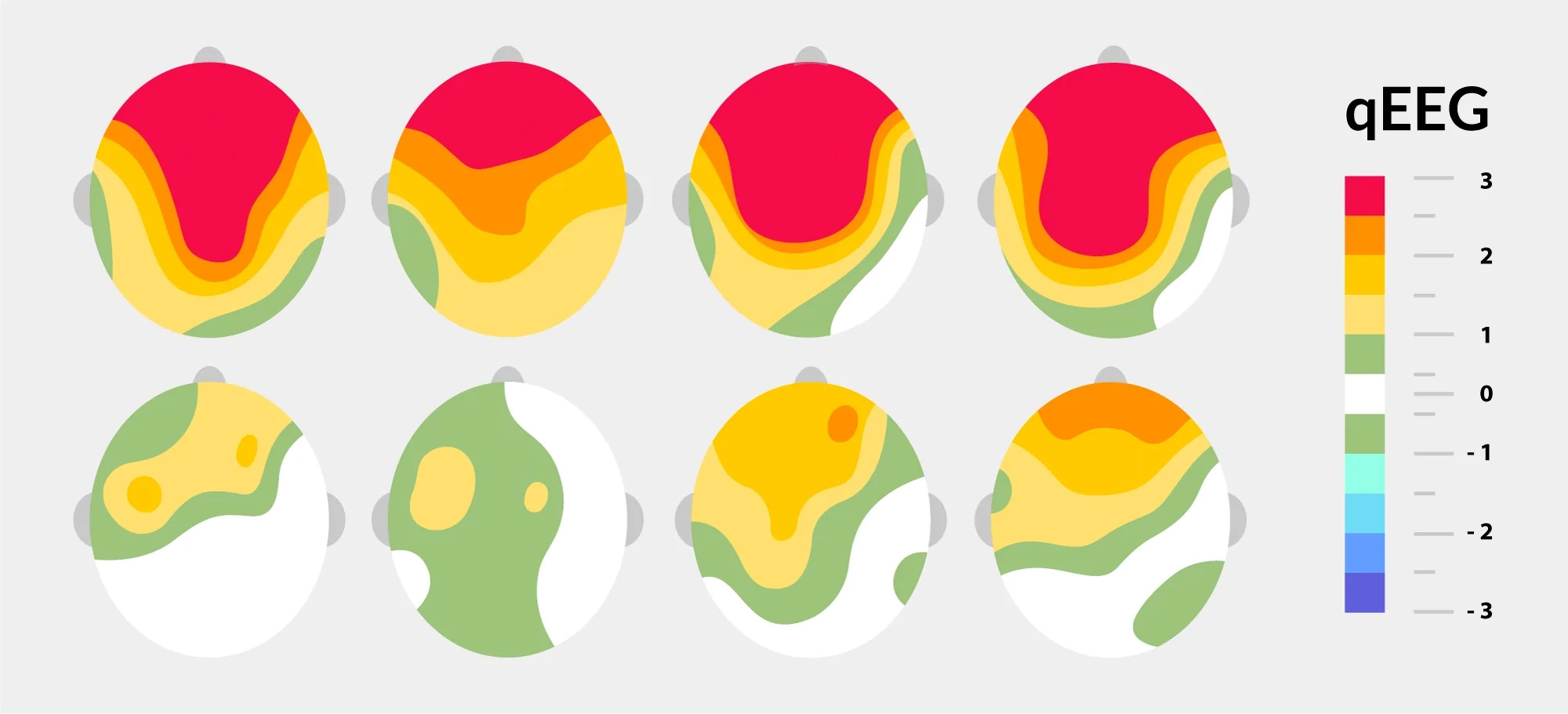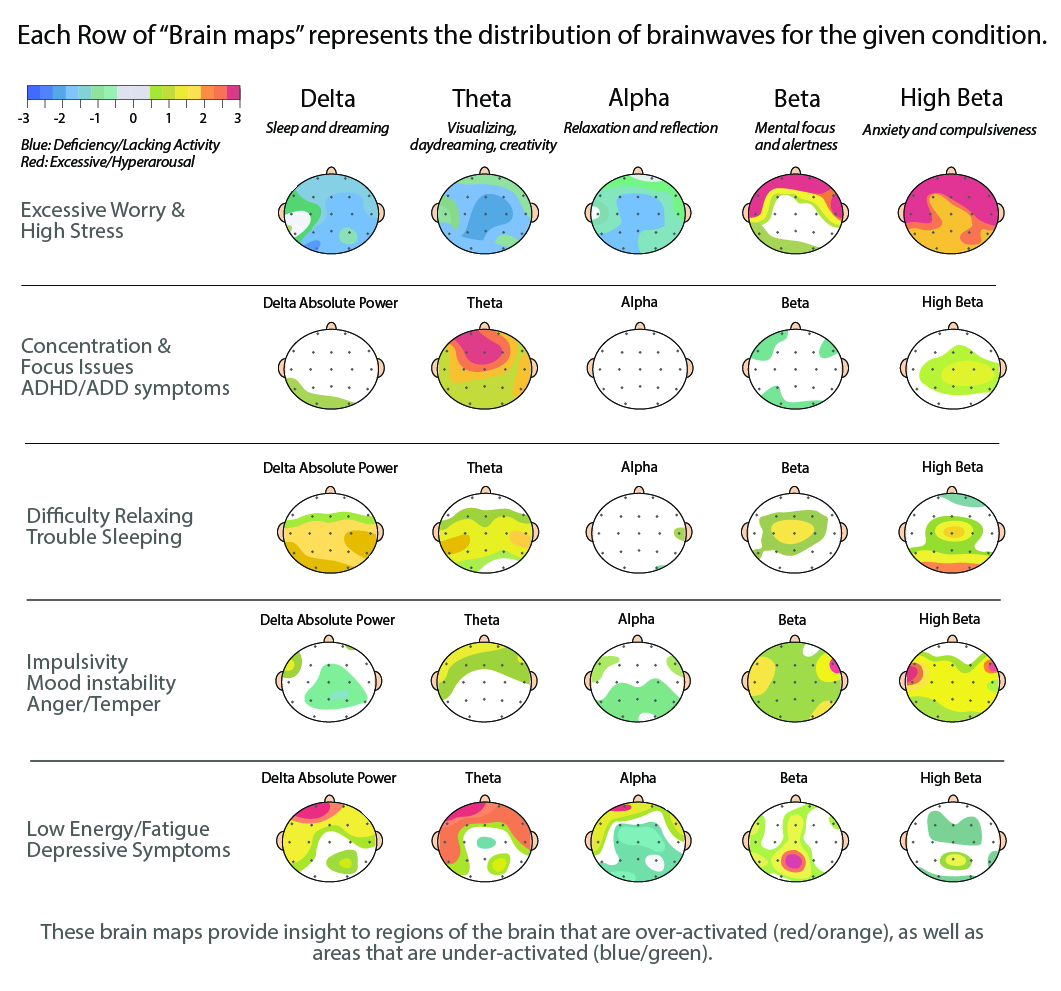- +1 800 433 4609
- |
- Request Info
- |
- Login
What is BrainView QEEG?
Quantitative Electroencephalography (QEEG) is a procedure that processes recorded EEG activity from a multi-electrode recording using a computer. The patient's digital EEG data is statistically analyzed and compared to normative database reference values in order to provide insight into differential diagnoses and effects of treatment. The processed EEG is commonly converted into color maps of brain functioning called "brain maps". The EEG and the derived QEEG information can be interpreted and used by experts as a clinical tool to evaluate brain function, and to track the changes in brain function due to various interventions such as neurofeedback or medication. QEEG processing techniques and advanced software allow the brain to view dynamic changes during a cognitive process. This novel approach assists in determining which areas of the brain are engaged and processing efficiently.

How is QEEG Brain Mapping Used?
Using QEEG, we can visualize and understand how the various parts of the brain function under different conditions. Through this, we can identify areas working well and functioning abnormally. Once this information is obtained, a proper management plant can be created, which focuses on improving the areas functioning sub-optimally.
Using QEEG, we can visualize and understand how the various parts of the brain function under different conditions. Through this, we can identify areas working well and functioning abnormally. Once this information is obtained, a proper management plant can be created, which focuses on improving the areas functioning sub-optimally.
What is QEEG Database?
QEEG stands for Quantitative Electroencephalography, commonly known as brain mapping. It can identify neuro markers or EEG phenotypes for various psychiatric disorders such as ADHD, Alzheimer's, Depression, dementia, schizophrenia, and PTSD. In addition, this information aids in forming personalizing treatments such as Neurofeedback or rTMS.
In addition to a wide range of diagnostic groups in a database, it is also necessary to have an excellent normative reference frame. Our normative database includes more than 40,000 healthy subjects and large patient groups with ADHD, TBI, PTSD, Alzheimer's disease, and Depression. The database also includes neurophysiological and neuropsychological data.
At the BrainView Research Institute, we have for the last decades been researching the optimal use of BrainView QEEG for optimizing psychiatric treatments. Furthermore, with our research, we are constantly pushing the envelope with the newest technologies and advances, such as source-localization, cross-frequency coupling, and deep learning to advance a future of stratified psychiatry or personalized psychiatry further.
The QEEG provides further analysis of visual EEG interpretation, offering more insight into understanding brain function. Quantitative Electroencephalography (qEEG) is a tool that processes recorded EEG activity using a computer. Electrical activity is measured by analysis of brain wave patterns. QEEG uses various algorithms, including wavelet analysis. The analyzed data is compared to a standard norm derived from a database.
The use of advanced techniques such as Independent Component Analysis (ICA) and neuro-imaging techniques such as Low Resolution Electromagnetic Tomography (eLORETA) can map the actual sources of the cortical rhythms. These advanced approaches are changing our understanding of the dynamics and function of the human brain.
QEEG stands for Quantitative Electroencephalography, commonly known as brain mapping. It can identify neuro markers or EEG phenotypes for various psychiatric disorders such as ADHD, Alzheimer's, Depression, dementia, schizophrenia, and PTSD. In addition, this information aids in forming personalizing treatments such as Neurofeedback or rTMS.
In addition to a wide range of diagnostic groups in a database, it is also necessary to have an excellent normative reference frame. Our normative database includes more than 40,000 healthy subjects and large patient groups with ADHD, TBI, PTSD, Alzheimer's disease, and Depression. The database also includes neurophysiological and neuropsychological data.
At the BrainView Research Institute, we have for the last decades been researching the optimal use of BrainView QEEG for optimizing psychiatric treatments. Furthermore, with our research, we are constantly pushing the envelope with the newest technologies and advances, such as source-localization, cross-frequency coupling, and deep learning to advance a future of stratified psychiatry or personalized psychiatry further.
The QEEG provides further analysis of visual EEG interpretation, offering more insight into understanding brain function. Quantitative Electroencephalography (qEEG) is a tool that processes recorded EEG activity using a computer. Electrical activity is measured by analysis of brain wave patterns. QEEG uses various algorithms, including wavelet analysis. The analyzed data is compared to a standard norm derived from a database.
The use of advanced techniques such as Independent Component Analysis (ICA) and neuro-imaging techniques such as Low Resolution Electromagnetic Tomography (eLORETA) can map the actual sources of the cortical rhythms. These advanced approaches are changing our understanding of the dynamics and function of the human brain.

